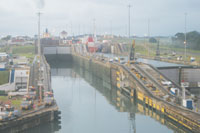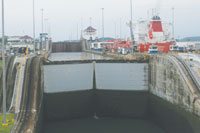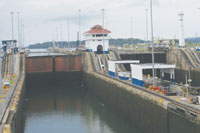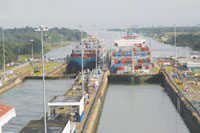
|
|
Boulder City Magazine® March 2007 Issue
|
Short Stories
The Panama Canal
by DeAnne Trompeter Appleby
The Panama Canal, located in south Central America, is a true engineering wonder. Its main purpose is to provide a convenient water passageway between the Atlantic and Pacific Oceans, bisecting North and South America.
The idea has been thought of since as early as the 16th century, when Spanish exploration and shipping began in both South and Central America. The French began work on the Canal in 1880. After decades of work and extremely difficult progress, the project was taken over in 1904 by the United States. The Canal was completed in 1913.
During the time the United States worked on the Canal, over 56,000 people were employed, and the construction costs were approximately $375 million. During construction, nearly 500 million cubic yards of earth were excavated, transported and disbursed.
|
The Canal is about 50 miles long and 8.5 miles across, and covers an area of approximately 164 square miles. It contains seventeen lakes, one of which acts as a reservoir for the Canal.
It contains three major sets of ship-lifting compartments or “locks”, Gatun, Miraflores and Petro Miguel. Each lock is about 110 feet wide by 1000 feet long. Ships are raised and lowered a total of 85 feet by the filling and emptying of the locks with water from the reservoir. Tugboats and small trains are used to help ships along their passage through the Canal, mainly at the entrances and exists of the locks.
Traveling from the Pacific to the Atlantic, a ship will enter the Gulf of Panama, and travel about 8 miles to the Miraflores Locks. It will then travel about 1 mile through the two-stage Miraflores locks and be lifted 54 feet up to Miraflores Lake. The ship will then travel about 1 mile across the lake, and enter the single-stage Pedro Miguel Lock. This lock is about 1 mile long, and the ship is lifted another 31 feet up to the main level of the Canal. The ship will then pass along the Gaillard Cut, the area of the greatest excavation in creating the Canal, for about 8 miles, and over the continental divide. The ship then passes into Lake Gatun, and travels about 15 miles to the Gatun Locks. The Gatun Locks are three-stage, and going through these locks, approximately 1 mile, the ship will be lowered back down to sea level.
The price for a ship to pass through the Canal is based on the ship’s type and size. The average ship costs around $60,000. A ship will take an average of 8 to10 hours to travel through the Canal. The journey through the Canal saves about 2 weeks and thousands of miles around South America. More than 14,000 ships per year use the Canal.
Until December 31, 1999, the United States had been a major part of the functioning and administration of the Canal since its completion in 1913. In 1977 the Panama Canal Treaty began the process of transferring the Canal to Panama, which occurred on December 31, 1999. Since then, the Canal has been in the control of the Panama Canal Authority, which is an entity of the Panamanian government and is responsible for the operation, administration and maintenance of the Canal. Today approximately 9,000 people work for the Canal, mostly locals.
Plans for the Canal include building 2 three-step lock sets, creating a new lane of traffic and doubling the Canal’s capacity. This tremendous project will be well worth keeping track of over the next few years.
If you are looking for more information about this engineering wonder, go to the Panama Canal Authority web site at www.pancanal.com.
|



 |
 Boulder City Magazine®
Boulder City Magazine®
688 Wells Rd #A
Boulder City, Nevada 89005
Phone (702) 294-1392 Fax (702) 294-1392
E-mail: BoulderCityMagazine@gmail.com

Web Site Design by Appleby Arts
Copyright © 2004, 2005, 2006, 2007 - Boulder City Magazine - All Rights Reserved
E-mail Web Master at: webmaster@bouldercitymagazine.com
Disclaimer
|





